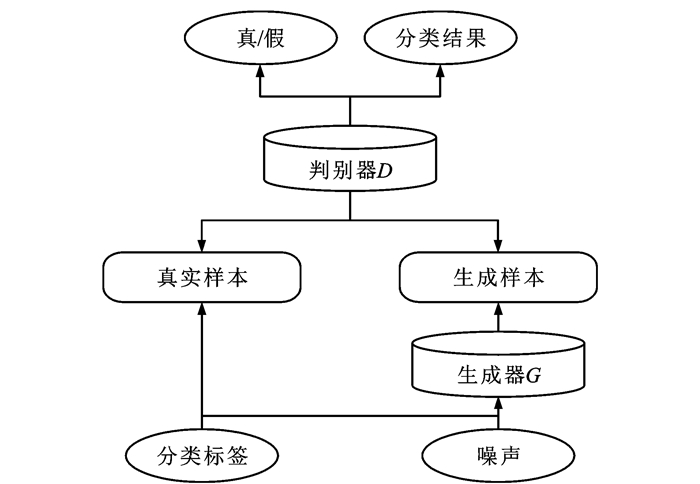Multi-mode data augmentation and fault diagnosis of gearbox using improved ACGAN
-
摘要: 针对现有生成对抗网络(GAN)难以高效率生成多模式的故障样本和训练不稳定问题,提出了一种改进辅助分类生成对抗网络(ACGAN),并将其用于齿轮箱多模式数据增强和智能故障诊断,以确保运载工具的安全运行;引入独立的分类器构建新型ACGAN框架,改善了经典ACGAN的分类精度与判别精度之间的兼容性;使用Wasserstein距离定义具有平滑特性的新型对抗损失函数,以此克服GAN易出现模式崩塌和梯度消失的缺点;引入谱归一化方法替代权重裁剪,限制判别器的权重参数,提高对抗训练过程的稳定性;为验证改进ACGAN的有效性和优越性,对齿轮箱的6类健康状态样本进行试验分析。分析结果表明:改进ACGAN生成的故障样本在数据层面和特征层面取得了更好的质量评估结果,其中基于结构相似度的评估指标平均优于对比方法0.249 3,基于最大平均差异的评估指标平均优于对比方法0.696 6;改进ACGAN的训练过程更加稳定,其损失函数具有更优的收敛性,同时在多模式故障诊断情景下具有更高的效率,其训练时间缩减为对比方法的20%;针对故障样本缺失的情况,改进ACGAN的生成样本能有效辅助深度学习智能故障诊断模型的训练,可将诊断精度由75.34%提升至97.06%。Abstract: To address the problems that the existing generative adversarial network (GAN) was difficult to efficiently generate multi-mode fault samples, and its training was unstable, an improved auxiliary classification GAN (ACGAN) was proposed for multi-mode data augmentation and intelligent fault diagnosis of the gearbox to ensure the safe operation of the vehicle. The independent classifier was introduced to construct a new ACGAN framework, and the compatibility between the classification accuracy and discriminant accuracy of classic ACGAN was improved. Wasserstein distances were used to define new adversarial loss functions with smooth properties, so as to overcome the disadvantages of the GAN, such as mode collapse and gradient vanishing. In order to improve the stability during the adversarial training process, the spectral normalization was used to replace the weight clipping to constrain the weight parameters of the discriminator. In order to verify the effectiveness and superiority of the improved ACGAN method, experimental analysis was performed on gearbox samples under six health conditions. Analysis results show that the fault samples generated by the improved ACGAN achieve better quality evaluation results at the data level and feature level, among which the evaluation index based on the structural similarity outperforms the comparison method by 0.249 3 on average, and the evaluation index based on the maximum mean difference outperforms the comparison method by 0.696 6 on average. The training process for the improved ACGAN is more stable. Its loss function has better convergence, and it has higher efficiency in multi-mode fault diagnosis scenarios with its training time reduced to 20% of the comparison method. In the case of missing fault samples, the generated fault samples of the improved ACGAN can effectively assist the training of intelligent fault diagnosis models based on deep learning, which can improve the diagnosis accuracy from 75.34% to 97.06%.
-
表 1 改进ACGAN结构参数
Table 1. Structure parameters of improved ACGAN
网络 结构参数 判别器 二维卷积层(5×5×32) 二维卷积层(3×3×64) 二维卷积层(3×3×128) 二维卷积层(3×3×256) 全连接层(1) 生成器 Embedding层(故障类别数量, 噪声维度) 全连接层(8 192) 二维转置卷积层(5×5×128) 二维转置卷积层(5×5×64) 二维转置卷积层(5×5×32) 二维转置卷积层(5×5×1) 分类器 二维卷积层(3×3×32)+最大池化层 二维卷积层(3×3×64) +最大池化层 二维卷积层(3×3×128) +最大池化层 二维卷积层(3×3×256) +最大池化层 全连接层(256) 全连接层(128) 全连接层(故障类别数量) 优化器 判别器(学习率为1.0×10-4,β1=0.5,β2=0.999) 生成器(学习率为1.0×10-4,β1=0.5,β2=0.999) 分类器(学习率为1.0×10-5,β1=0.9,β2=0.999) 表 2 齿轮箱健康状态描述
Table 2. Details of health states of gearbox
健康状态标签 健康状态信息 C0 正常 C1 32齿齿轮纵向剥落,48齿齿轮点蚀 C2 48齿齿轮点蚀 C3 48齿齿轮点蚀,80齿齿轮断齿,轴承1滚动体故障 C4 32齿齿轮纵向剥落,48齿齿轮点蚀,80齿齿轮断齿,轴承1内圈故障,轴承2滚动体故障,轴承3外圈故障 C5 80齿齿轮断齿,轴承1内圈故障,轴承2滚动体故障,轴承3外圈故障,主动轴不平衡 表 3 不同方法的故障诊断性能对比
Table 3. Comparison of fault diagnosis performances of different methods
真实样本数 添加生成样本数 故障诊断准确率/% 添加真实样本数 改进ACGAN WGAN-GP ACGAN 50 0 70.66±1.40 50 25 77.02±1.30 75.34±1.88 76.12±1.59 73.31±1.26 50 50 91.57±0.57 90.80±0.28 90.98±0.68 74.20±1.41 50 75 94.68±0.32 93.64±0.31 93.40±0.25 74.94±1.28 50 100 96.64±0.52 94.94±0.50 94.61±0.87 75.09±1.45 50 125 97.42±0.61 95.92±0.51 95.56±0.45 76.26±1.12 50 150 98.81±0.58 97.06±0.69 96.70±0.61 77.54±1.68 表 4 不同方法的训练时间对比
Table 4. Comparison of training times of different methods
数据增强方法 需训练的GAN模型数量 收敛时的迭代次数 总训练时间/s 改进ACGAN 1 20 000 5 240 WGAN-GP 6 15 000(平均) 26 736 ACGAN 1 不收敛 7 083(30 000次迭代) -
[1] 雷亚国, 许学方, 蔡潇, 等. 面向机械装备健康监测的数据质量保障方法研究[J]. 机械工程学报, 2021, 57(4): 1-9. https://www.cnki.com.cn/Article/CJFDTOTAL-JXXB202104001.htmLEI Ya-guo, XU Xue-fang, CAI Xiao, et al. Research on data quality assurance for health condition monitoring of machinery[J]. Journal of Mechanical Engineering, 2021, 57(4): 1-9. (in Chinese) https://www.cnki.com.cn/Article/CJFDTOTAL-JXXB202104001.htm [2] 朱海燕, 王超文, 邬平波, 等. 基于小滚轮高频激励的高速列车齿轮箱箱体振动试验[J]. 交通运输工程学报, 2020, 20(5): 135-150. doi: 10.19818/j.cnki.1671-1637.2020.05.011ZHU Hai-yan, WANG Chao-wen, WU Ping-bo, et al. High-speed train gearbox housing vibration test based on small roller high-frequency excitation[J]. Journal of Traffic and Transportation Engineering, 2020, 20(5): 135-150. (in Chinese) doi: 10.19818/j.cnki.1671-1637.2020.05.011 [3] 江星星, 宋秋昱, 朱忠奎, 等. 基于收敛趋势变分模式分解的齿轮箱故障诊断方法[J]. 交通运输工程学报, 2022, 22(1): 177-189. doi: 10.19818/j.cnki.1671-1637.2022.01.015JIANG Xing-xing, SONG Qiu-yu, ZHU Zhong-kui, et al. Gearbox fault diagnosis method based on convergent trend-guided variational mode decomposition[J]. Journal of Traffic and Transportation Engineering, 2022, 22(1): 177-189. (in Chinese) doi: 10.19818/j.cnki.1671-1637.2022.01.015 [4] SHAO Hai-dong, LIN Jing, ZHANG Liang-wei, et al. A novel approach of multisensory fusion to collaborative fault diagnosis in maintenance[J]. Information Fusion, 2021, 74: 65-76. doi: 10.1016/j.inffus.2021.03.008 [5] ZHAO Hui-min, LIU Jie, CHEN Hua-yue, et al. Intelligent diagnosis using continuous wavelet transform and gauss convolutional deep belief network[J]. IEEE Transactions on Reliability, 2020, 197: 105883. [6] 邵海东, 张笑阳, 程军圣, 等. 基于提升深度迁移自动编码器的轴承智能故障诊断[J]. 机械工程学报, 2020, 56(9): 84-90. https://www.cnki.com.cn/Article/CJFDTOTAL-JXXB202009011.htmSHAO Hai-dong, ZHANG Xiao-yang, CHENG Jun-sheng, et al. Intelligent fault diagnosis of bearing using enhanced deep transfer auto-encoder[J]. Journal of Mechanical Engineering, 2020, 56(9): 84-90. (in Chinese) https://www.cnki.com.cn/Article/CJFDTOTAL-JXXB202009011.htm [7] 张龙, 甄灿壮, 熊国良, 等. 基于深度时频特征的机车轴承故障诊断[J]. 交通运输工程学报, 2021, 21(6): 247-258. doi: 10.19818/j.cnki.1671-1637.2021.06.019ZHANG Long, ZHEN Can-zhuang, XIONG Guo-liang, et al. Locomotive bearing fault diagnosis based on deep time-frequency features[J]. Journal of Traffic and Transportation Engineering, 2021, 21(6): 247-258. (in Chinese) doi: 10.19818/j.cnki.1671-1637.2021.06.019 [8] 池永为, 杨世锡, 焦卫东. 基于LSTM-RNN的滚动轴承故障多标签分类方法[J]. 振动、测试与诊断, 2020, 40(3): 563-571, 629. https://www.cnki.com.cn/Article/CJFDTOTAL-ZDCS202003021.htmCHI Yong-wei, YANG Shi-xi, JIAO Wei-dong. A multi-label fault classification method for rolling bearing based on LSTM-RNN[J]. Journal of Vibration, Measurement and Diagnosis, 2020, 40(3): 563-571, 629. (in Chinese) https://www.cnki.com.cn/Article/CJFDTOTAL-ZDCS202003021.htm [9] SURENDRAN R, KHALAF O, ROMERO C. Deep learning based intelligent industrial fault diagnosis model[J]. Computers, Materials and Continua, 2022, 70(3): 6323-6338. doi: 10.32604/cmc.2022.021716 [10] CHEN Hong-tian, JIANG Bing, DING S, et al. Data-driven fault diagnosis for traction systems in high-speed trains: a survey, challenges, and perspectives[J]. IEEE Transactions on Intelligent Transportation Systems, 2022, 23(3): 1700-1716. [11] ZHAO Rui, YAN Ru-qiang, CHEN Zheng-hua, et al. Deep learning and its applications to machine health monitoring[J]. Mechanical Systems and Signal Processing, 2019, 115: 213-237. [12] 沈长青, 王旭, 王冬, 等. 基于多尺度卷积类内迁移学习的列车轴承故障诊断[J]. 交通运输工程学报, 2020, 20(5): 151-164. doi: 10.19818/j.cnki.1671-1637.2020.05.012SHEN Chang-qing, WANG Xu, WANG Dong, et al. Multi-scale convolution intra-class transfer learning for train bearing fault diagnosis[J]. Journal of Traffic and Transportation Engineering, 2020, 20(5): 151-164. (in Chinese) doi: 10.19818/j.cnki.1671-1637.2020.05.012 [13] 邵海东, 肖一鸣, 颜深. 仿真数据驱动的改进无监督域适应轴承故障诊断[J]. 机械工程学报, 2023, 59(3): 76-85. https://www.cnki.com.cn/Article/CJFDTOTAL-JXXB202303008.htmSHAO Hai-dong, XIAO Yi-ming, YAN Shen. Simulation data-driven enhanced unsupervised domain adaptation for bearing fault diagnosis[J]. Journal of Mechanical Engineering, 2023, 59(3): 76-85. (in Chinese) https://www.cnki.com.cn/Article/CJFDTOTAL-JXXB202303008.htm [14] GOODFELLOW I J, POUGET-ABADIE J, MIRZA M, et al. Generative adversarial networks[J]. Advances in Neural Information Processing Systems, 2014, 3: 2672-2680. [15] WANG Zi-rui, WANG Jun, WANG You-ren. An intelligent diagnosis scheme based on generative adversarial learning deep neural networks and its application to planetary gearbox fault pattern recognition[J]. Neurocomputing, 2018, 310(8): 213-222. [16] 何强, 唐向红, 李传江, 等. 负载不平衡下小样本数据的轴承故障诊断[J]. 中国机械工程, 2021, 32(10): 1164-1171, 1180. https://www.cnki.com.cn/Article/CJFDTOTAL-ZGJX202110004.htmHE Qiang, TANG Xiang-hong, LI Chuan-jiang, et al. Bearing fault diagnosis method based on small sample data under unbalanced loads[J]. China Mechanical Engineering, 2021, 32(10): 1164-1171, 1180. (in Chinese) https://www.cnki.com.cn/Article/CJFDTOTAL-ZGJX202110004.htm [17] 戴俊, 王俊, 朱忠奎, 等. 基于生成对抗网络和自动编码器的机械系统异常检测[J]. 仪器仪表学报, 2019, 40(9): 16-26. https://www.cnki.com.cn/Article/CJFDTOTAL-YQXB201909002.htmDAI Jun, WANG Jun, ZHU Zhong-kui, et al. Anomaly detection of mechanical systems based on generative adversarial network and auto-encoder[J]. Chinese Journal of Scientific Instrument, 2019, 40(9): 16-26. (in Chinese) https://www.cnki.com.cn/Article/CJFDTOTAL-YQXB201909002.htm [18] LIU Shen, CHEN Jing-long, QU Cheng, et al. LOSGAN: latent optimized stable GAN for intelligent fault diagnosis with limited data in rotating machinery[J]. Measurement Science and Technology, 2021, 32: 045101. [19] GONG Jia-liang, XU Xiao-dong, LEI Ying-ke. Unsupervised specific emitter identification method using radio-frequency fingerprint embedded InfoGAN[J]. IEEE Transactions on Information Forensics and Security, 2020, 15: 2898-2912. [20] RASTOGI R, GANGNANI R. Semi-supervised multi category classification with generative adversarial networks[C]//Springer. 2019 International Conference on Pattern Recognition and Machine Intelligence. Berlin: Springer, 2019: 286-294. [21] ODENA A, OLAH C, SHLENS J. Conditional image synthesis with auxiliary classifier GANs[C]//ACM. 2017 International Conference on Machine Learning. Sydney: ACM, 2017: 2642-2651. [22] SHAO Si-yu, WANG Pu, YAN Ru-qiang. Generative adversarial networks for data augmentation in machine fault diagnosis[J]. Computers in Industry, 2019, 106: 85-93. [23] GUO Qing-wen, LI Yi-bin, SONG Yan, et al. Intelligent fault diagnosis method based on full 1-D convolutional generative adversarial network[J]. IEEE Transactions on Industrial Informatics, 2020, 16(3): 2044-2053. [24] 肖雄, 肖宇雄, 张勇军, 等. 基于二维灰度图的数据增强方法在电机轴承故障诊断的应用研究[J]. 中国电机工程学报, 2021, 41(2): 738-749. https://www.cnki.com.cn/Article/CJFDTOTAL-ZGDC202102032.htmXIAO Xiong, XIAO Yu-xiong, ZHANG Yong-jun, et al. Research on the application of the data augmentation method based on 2D gray pixel images in the fault diagnosis of motor bearing[J]. Proceedings of the CSEE, 2021, 41(2): 738-749. (in Chinese) https://www.cnki.com.cn/Article/CJFDTOTAL-ZGDC202102032.htm [25] 孙灿飞, 王友仁, 夏裕彬. 基于SCAE-ACGAN的直升机行星齿轮裂纹故障诊断[J]. 振动、测试与诊断, 2021, 41(3): 495-502, 620-621. https://www.cnki.com.cn/Article/CJFDTOTAL-ZDCS202103012.htmSUN Can-fei, WANG You-ren, XIA Yu-bin. Fault diagnosis of helicopter planetary gear tooth crack based on SCAE-ACGAN[J]. Journal of Vibration, Measurement and Diagnosis, 2021, 41(3): 495-502, 620-621. (in Chinese) https://www.cnki.com.cn/Article/CJFDTOTAL-ZDCS202103012.htm [26] LEE M H, SEOK J H, Controllable generative adversarial network[J]. IEEE Access, 2019, 7: 28158-28169. [27] ARJOVSKY M, CHINTALA S, BOTTOU L. Wasserstein generative adversarial networks[C]//ACM. International Conference on Machine Learning. Sydney: ACM, 2017: 214-233. [28] XIA Wei-hao, ZHANG Yu-lun, YANG Yu-jiu, et al. GAN inversion: a survey[J]. IEEE Transactions on Pattern Analysis and Machine Intelligence, 2023, 45(3): 3121-3138. [29] ALATAT H, SIEGEL D, LEE J. A systematic methodology for gearbox health assessment and fault classification[J]. Journal of Prognostics and Health Management, 2011, 2(1): 16-22. [30] WEN Long, LI Xin-yu, GAO Liang, et al. A new convolutional neural network-based data-driven fault diagnosis method[J]. IEEE Transactions on Industrial Electronics, 2018, 65(7): 5990-5998. [31] 马燕, 余海军, 钟发生, 等. 基于残差编解码网络的CT图像金属伪影校正[J]. 仪器仪表学报, 2020, 41(8): 160-169. https://www.cnki.com.cn/Article/CJFDTOTAL-YQXB202008018.htmMA Yan, YU Hai-jun, ZHONG Fa-sheng, et al. CT metal artifact reduction based on the residual encoder-decoder network[J]. Chinese Journal of Scientific Instrument, 2020, 41(8): 160-169. (in Chinese) https://www.cnki.com.cn/Article/CJFDTOTAL-YQXB202008018.htm -





 下载:
下载:











